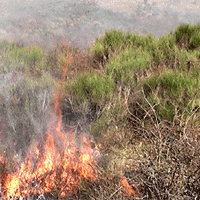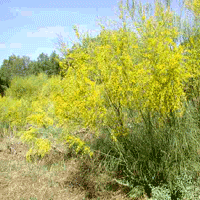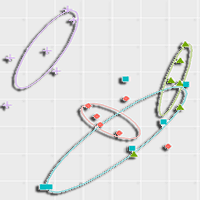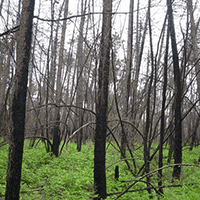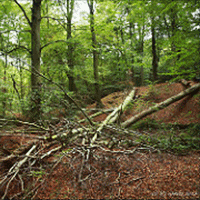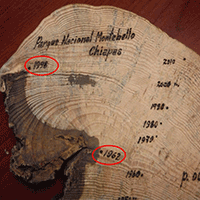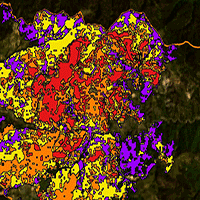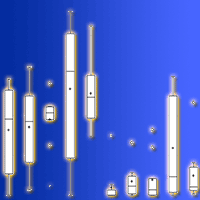Serotiny degree may hypothetically depend on mother plant age and fire severity, and fire severity can strongly affect the regeneration of Pinus pinaster Aiton, which is an obligate seeder species with aerial seed banks stocked in cones showing a certain degree of serotiny. The main objective of this study was to evaluate the effect of serotiny and mother plant age on seed germination of P. pinaster in relation to fire severity. For this purpose, cones were collected in two stands from mother trees of different ages. Serotinous cones were opened in oven at increasing temperatures to determine the number of seeds released. The length of cones and the number and weight of seeds were measured. Seeds from both classes of mother plant age were subjected to 34 different treatments simulating different fire severity levels, and their germination was recorded. The results showed that serotiny was significantly higher in cones from young mother trees. Seed germination in the control groups from serotinous cones was always higher than that from non-serotinous cones without thermal shock. Fire severity decreased seed germination as fire severity increases in both mother age classes. Mother plant age was related to the serotiny level, which was higher in young than in old trees, suggesting a strong selection in the population due to a recent fire.
Keywords
, , , , ,
Citation
Cruz O, García-Duro J, Casal M, Reyes O (2019). Role of serotiny on Pinus pinaster Aiton germination and its relation to mother plant age and fire severity. iForest 12: 491-497. - doi: 10.3832/ifor2968-012
Academic Editor
Andrea Cutini
Paper history
Received: Oct 04, 2018
Accepted: Aug 08, 2019
First online: Nov 02, 2019
Publication Date: Dec 31, 2019
Publication Time: 2.87 months
© SISEF - The Italian Society of Silviculture and Forest Ecology 2019
Open Access
This article is distributed under the terms of the Creative Commons Attribution-Non Commercial 4.0 International (https://creativecommons.org/licenses/by-nc/4.0/), which permits unrestricted use, distribution, and reproduction in any medium, provided you give appropriate credit to the original author(s) and the source, provide a link to the Creative Commons license, and indicate if changes were made.

Breakdown by View Type
(Waiting for server response...)
Article Usage
Total Article Views: 45058
(from publication date up to now)
Breakdown by View Type
HTML Page Views: 37849
Abstract Page Views: 3712
PDF Downloads: 2640
Citation/Reference Downloads: 7
XML Downloads: 850
Web Metrics
Days since publication: 2234
Overall contacts: 45058
Avg. contacts per week: 141.18
Article Citations
Article citations are based on data periodically collected from the Clarivate Web of Science web site
(last update: Mar 2025)
Total number of cites (since 2019): 17
Average cites per year: 2.43
Publication Metrics
by Dimensions ©
Articles citing this article
List of the papers citing this article based on CrossRef Cited-by.
(1)
Akaike H (1974)A new look at the statistical model identification. Automatic Control 19: 716-723.
CrossRef |
Gscholar
(2)
Alfaro-Sánchez R, López-Serrano FR, Rubio E, Sánchez-Salguero R, Moya D, Hernández-Tecles E, De las Heras J (2015)Response of biomass allocation patterns to thinning in
Pinus halepensis differs under dry and semiarid Mediterranean climates. Annals of Forest Science 72: 595-607.
CrossRef |
Gscholar
(3)
Alvarez R, Valbuena L, Calvo L (2007)Effect of high temperatures on seed germination and seedling survival in three pine species (
Pinus pinaster, P. sylvestris and
P. nigra). International Journal of Wildland Fire 16: 63-70.
CrossRef |
Gscholar
(4)
Bradstock RA, Auld TD (1995)Soil temperatures during experimental bushfires in relation to fire intensity: consequences for legume germination and fire management in South-Eastern Australia. Journal of Applied Ecology 32: 76-84.
CrossRef |
Gscholar
(5)
Buss W, Mašek O (2014)Mobile organic compounds in biochar - A potential source of contamination - Phytotoxic effects on cress seed (
Lepidium sativum) germination. Journal of Environmental Management 137: 111-119.
CrossRef |
Gscholar
(6)
Calvo L, García-Domínguez C, Naranjo A, Arévalo JR (2013)Effects of light/darkness, thermal shocks and inhibitory components on germination of
Pinus canariensis,
Pinus halepensis and
Pinus pinea. European Journal of Forest Research 132: 909-917.
CrossRef |
Gscholar
(7)
Calvo L, Hernández V, Valbuena L, Taboada A (2016)Provenance and seed mass determine seed tolerance to high temperatures associated to forest fires in
Pinus pinaster. Annals of Forest Sciences 73: 381-391.
CrossRef |
Gscholar
(8)
Crosti R, Ladd PG, Dixon KW, Piotto B (2006)Post-fire germination: the effect of smoke on seeds of selected species from the central Mediterranean basin. Forest Ecology and Management 221: 306-312.
CrossRef |
Gscholar
(9)
Cruz O, García-Duro J, Casal M, Reyes O (2017)Can the mother plant age of
Acacia melanoxylon (Leguminosae) modulate the germinative response to fire? Australian Journal of Botany 65: 593-600.
CrossRef |
Gscholar
(10)
Davies SJ, Unam L (1999)Smoke-haze from the 1997 Indonesian forest fires: effects on pollution levels, local climate, atmospheric CO
2 concentrations, and tree photosynthesis. Forest Ecology and Management 124: 137-144.
CrossRef |
Gscholar
(11)
DeBano L, Dunn P, Conrad C (1977)Fire’s effect on physical and chemical properties of chaparral soils, In: Proceedings of the Symposium “Environmental Consequences of Fire and Fuel Management in Mediterranean Ecosystems” (Mooney HA, Conrad C eds). General Technical Report WO-3, USDA Forest Service, Washington, DC, USA, pp. 65-74.
Gscholar
(12)
De Las Heras J, Moya D, Vega JA, Daskalakou E, Vallejo R, Grigoriadis N, Tsitsoni T, Baeza J, Valdecantos A, Fernández C, Espelta J, Fernandes P (2012)Post-fire management of serotinous pine forests. In: “Post-Fire Management and Restoration of Southern European Forests” (Moreira F, Arianoutsou M, Corona P, De las Heras J eds). Managing Forest Ecosystems, vol. 24, Springer, Dordrecht, Netherlands, pp. 121-150.
CrossRef |
Gscholar
(13)
ENSCONET (2017)European native seed conservation network. Web site.
Online |
Gscholar
(14)
Escudero A, Sanz MV, Pita JM, Pérez-García F (1999)Probability of germination after heat treatment of native Spanish pines. Annals of Forest Sciences 56: 511-520.
CrossRef |
Gscholar
(15)
Espelta JM, Arnan X, Rodrigo A (2011)Non-fire induced seed release in a weakly serotinous pine: climatic factors, maintenance costs or both? Oikos 120: 1752-1760.
CrossRef |
Gscholar
(16)
Ganatsas P, Tsakaldimi M, Thanos C (2008)Seed and cone diversity and seed germination of
Pinus pinea in Strofylia site of the Natura 2000 Network. Biodiversity and Conservation 17: 2427-2439.
CrossRef |
Gscholar
(17)
Gauthier S, Bergeron Y, Simon JP (1996)Effects of fire regime on the serotiny level of jack pine. Journal of Ecology 84: 539-548.
CrossRef |
Gscholar
(18)
González De Vega S, De Las Heras J, Moya D (2016)Resilience of Mediterranean terrestrial ecosystems and fire severity in semiarid areas: Responses of Aleppo pine forests in the short, mid and long term. Science of the Total Environment 573: 1171-1177.
CrossRef |
Gscholar
(19)
Goubitz S, Werger MJA, Neeman G (2003)Germination response to fire-related factors of seeds from non-serotinous and serotinous cones. Plant Ecology 169: 195-204.
CrossRef |
Gscholar
(20)
Hernández-Serrano A, Verdú M, González-Martínez SC, Pausas JG (2013)Fire structures pine serotiny at different scales. American Journal of Botany 100: 2349-2356.
CrossRef |
Gscholar
(21)
Hernández-Serrano A, Verdú M, Santos-Del-Blanco L, Climent J, González-Martínez SC, Pausas JG (2014)Heritability and quantitative genetic divergence of serotiny, a fire-persistence plant trait. Annals of Botany 114: 571-577.
CrossRef |
Gscholar
(22)
IPCC (2014)Climate change 2014: impacts, adaptation and vulnerability. Part A: Global and sectoral aspects. Contribution of Working Group II to the Fifth Assessment Report of the Intergovernmental Panel on Climate Change, Cambridge University Press, Cambridge, UK, pp. 1101-1131.
Gscholar
(23)
Keeley JE (2009)Fire intensity, fire severity and burn severity: a brief review and suggested usage. International Journal of Wildland Fire 18: 116-126.
CrossRef |
Gscholar
(24)
Lanner R (1998)Seed dispersal in
Pinus. In: “Ecology and Biogeography of
Pinus” (Richardson DM, Rundel P eds). Cambridge University Press, Cambridge, UK, pp. 381-395.
Gscholar
(25)
Lembicz M, Olejniczak P, Zukowski W, Bogdanowicz AM (2011)Effect of mother plant age on germination and size of seeds and seedlings in the perennial sedge
Carex secalina (Cyperaceae). Flora - Morphology, Distribution, Functional Ecology of Plants 206 (2): 158-163.
CrossRef |
Gscholar
(26)
Lloret F (2004)Régimen de incendios y regeneración [Fire regime and regeneration]. In: “Ecología del Bosque Mediterráneo en un Mundo Cambiante” (Valladares F ed). Ministerio de Medio Ambiente, EGRAFSA, Madrid, Spain, pp. 101-126. [in Spanish]
Gscholar
(27)
Madrigal J, Souto-García J, Calama R, Guijarro M, Picos J, Hernando C (2019)Resistance of
Pinus pinea L. bark to fire. International Journal of Wildland Fire 28: 342-353.
CrossRef |
Gscholar
(28)
Martín-Sanz RC, Santos-Del-Blanco L, Notivol E, Chambel MR, San-Martin R, Climent J (2016)Disentangling plasticity of serotiny, a key adaptive trait in a Mediterranean conifer. American Journal of Botany 103: 1582-1591.
CrossRef |
Gscholar
(29)
Martín-Sanz RC, Callejas-Díaz M, Tonnabel J, Climent JM (2017)Maintenance costs of serotiny in a variably serotinous pine: the role of water supply. PLoS One 12 (7): e0181648.
CrossRef |
Gscholar
(30)
McGinley MA, Smith CC, Elliott PF, Higgins JJ (1990)Morphological constraints on seed mass in Lodgepole pine. Functional Ecology 4: 183-192.
CrossRef |
Gscholar
(31)
Meteogalicia (2019)Meteogalicia web site. Conselleria de Medio Ambiente, Territorio e Vivenda, Xunta de Galicia, Spain. [in Spanish]
Online |
Gscholar
(32)
Moreira F, Arianoutsou M, Corona P, De las Heras J (2012)Post-fire management and restoration of Southern European forests. Springer Science and Business Media, Dordrecht, Netherlands, pp. 330.
Gscholar
(33)
Mousseau T, Fox C (1998)The adaptive significance of maternal effects. Trends in Ecology and Evolution 13: 403-407.
CrossRef |
Gscholar
(34)
Moya D, Heras J, Salvatore R, Valero E, Leone V (2013)Fire intensity and serotiny: response of germination and enzymatic activity in seeds of
Pinus halepensis Mill. from southern Italy. Annals of Forest Sciences 70: 49-59.
CrossRef |
Gscholar
(35)
Niccoli F, Esposito A, Altieri S, Battipaglia G (2019)Fire severity influences ecophysiological responses of
Pinus pinaster Ait. Frontiers in Plant Science. 10: 539.
CrossRef |
Gscholar
(36)
Ohlson M, Tryterud E (2000)Interpretation of the charcoal record in forest soils: forest fires and their production and deposition of macroscopic charcoal. The Holocene 10: 519-525.
CrossRef |
Gscholar
(37)
Otto R, García-Del-Rey E, Muñoz PG, Fernández-Palacios JM (2010)The effect of fire severity on first-year seedling establishment in a
Pinus canariensis forest on Tenerife, Canary Islands. European Journal of Forest Research 129: 499-508.
CrossRef |
Gscholar
(38)
PSG (2018)Propiedade Solos Galicia, web site. Departemento de Edafologia Y Quimica Agricola, USC, Santiago de Compostela, Spain, web site. [in Spanish]
Online |
Gscholar
(39)
R Core Team (2015)R: a language and environment for statistical computing. R Foundation for Statistical Computing, Vienna, Austria.
Online |
Gscholar
(40)
Reyes O, Casal M (2004)Effects of forest fire ash on germination and early growth of four
Pinus species. Plant Ecology 175 (1): 81-89.
CrossRef |
Gscholar
(41)
Reyes O, Casal M (2006)Can smoke affect the germination of
Pinus sylvestris, P. nigra, P. uncinata and
P. pinaster? Forest Ecology and Management 234 (s15): S184.
CrossRef |
Gscholar
(42)
Reyes O, García-Duro J, Salgado J (2015a)Fire affects soil organic matter and the emergence of
Pinus radiata seedlings. Annals of Forest Sciences 72: 267-275.
CrossRef |
Gscholar
(43)
Reyes O, Kaal J, Arán D, Gago R, Bernal J, García-Duro J, Basanta M (2015b)The effects of ash and black carbon (biochar) on germination of different tree species. Fire Ecology 11: 119-133.
CrossRef |
Gscholar
(44)
Rodrigo A, Retana J, Picó FX (2004)Direct regeneration is not the only response of Mediterranean forests to large fires. Ecology 85: 716-729.
CrossRef |
Gscholar
(45)
Soto B, Basanta R, Diaz-Fierros F (1997)Effects of burning on nutrient balance in an area of gorse (
Ulex europaeus L.) scrub. Science of The Total Environment 204: 271-281.
CrossRef |
Gscholar
(46)
Tapias R, Gil L, Fuentes-Utrilla P, Pardos JA (2001)Canopy seed banks in Mediterranean pines of south-eastern Spain: a comparison between
Pinus halepensis Mill.,
P. pinaster Ait.,
P. nigra Arn. and
P. pinea L. Journal of Ecology 89: 629-638.
CrossRef |
Gscholar
(47)
Tapias R, Climent J, Pardos JA, Gil L (2004)Life histories of Mediterranean pines. Plant Ecology 171: 53-68.
CrossRef |
Gscholar
(48)
Tessler N, Wittenberg L, Provizor E, Greenbaum N (2014)The influence of short-interval recurrent forest fires on the abundance of Aleppo pine (
Pinus halepensis Mill.) on Mount Carmel, Israel. Forest Ecology and Management 324: 109-116.
CrossRef |
Gscholar
(49)
Tíscar P (2002)Capacidad reproductiva de
Pinus nigra subsp.
salzmannii en relación con la edad de la planta madre [Reproductive capacity of
Pinus nigra subsp.
salzmannii in relation to the age of the mother plant]. Investigaciones Agrarias: Sistemas y Recursos Forestales 11: 357-372. [in Spanish]
Online |
Gscholar
(50)
Trabaud L (1979)Etude du comportement du feu dans la Garrigue de Chêne kermès à partir des températures et des vitesses de propagation [Study of fire behavior in the Garrigue de Kermes Oak from temperatures and propagation velocities]. Annals of Forest Sciences 36: 13-38. [in French]
CrossRef |
Gscholar
(51)
Trabaud L (1995)Modalités de germination des cistes et des pins méditerranéens et colonisation des sites perturbés [Germination of mediterranean
Cistus spp. and
Pinus spp. and their reoccupation of disturbed sites]. Revue d’Écologie 1: 3-14. [in French]
Online |
Gscholar
(52)
Vega JA (2000)Resistencia vegetativa ante el fuego a través de la historia de los incendios [Vegetative resistance to fire through the history of fires]. In: “La Defensa Contra Incendios Forestales: Fundamentos y Experiencias” (Velez R ed). McGraw-Hill, Madrid, Spain, pp. 66-85. [in Spanish]
Gscholar
(53)
Vega JA, Fernández C, Pérez-Gorostiaga P, Fonturbel T (2008)The influence of fire severity, serotiny, and post-fire management on Pinus pinaster Ait. recruitment in three burnt areas in Galicia (NW Spain). Forest Ecology and Management 256: 1596-1603.
CrossRef |
Gscholar
(54)
Vincenzi S, Piotti A (2014)Evolution of serotiny in maritime pine (
Pinus pinaster) in the light of increasing frequency of fires. Plant Ecology 215: 689-701.
CrossRef |
Gscholar
(55)
Willian RL (1985)A guide to forest seed handling. FAO Forestry Paper 20/2, FAO, Rome, Italy, pp. 379.
Online |
Gscholar
(56)
Zas R, Sampedro L (2015)Heritability of seed weight in Maritime pine, a relevant trait in the transmission of environmental maternal effects. Heredity 114: 116-124.
CrossRef |
Gscholar
(57)
Zedler PH (1995)Fire frequency in southern California shrublands: biological effects and management options. In: “Brushfires in California: Ecology and Resource Management” (Keeley JE, Scott T eds). International Association of Wildland Fire, Fairfield, Washington, DC, USA, pp. 101-112.
Gscholar


